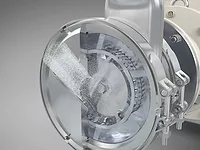From the Lab to the Real World: New Design in Mixing/Dispersion Equipment Allows More Efficient Development and Scale-Up

During the last few years, new directions in product development have added to the challenge of managing R&D. The drive to reduce VOCs, both with waterborne formulations and with formulations that require lower solvent content, has introduced many new variables in raw materials, special-purpose additives, mixing/dispersion equipment, and process techniques that must be considered in developing new products.
In this environment, any equipment that provides a boost in versatility and efficiency, and enables development engineers to be more productive, is a welcome improvement. A single machine that can do the work of two, three or even four machines can save space in the lab and cut operating costs sharply.
When a piece of equipment provides the tools necessary to quickly compare the advantages of competing mixing techniques - using a method that is controlled, quantifiable, and projectable for scale-up - its value in the laboratory is far greater. It allows the development engineer to combine two dimensions of laboratory testing and development: to refine the formulation and identify the optimal process for a new product.

Rotor/Stator Mixer or High-Speed Disperser: Which is Best?
Many coatings manufacturers have found that they can no longer safely presume that a traditional high-speed disperser (HSD) is the best way to make contemporary products. The rules have changed.Many have found, for example, that waterborne systems require the higher shear of a rotor/stator mixer to achieve a product with the desired properties - such as droplet size, stability, agglomerate size and color development.
Waterborne products are extremely vulnerable to air entrainment, and the familiar vortex created by the HSD can cause serious foaming problems. To reduce the foam, formulators can add a defoaming agent, which adds cost and can also affect other properties - requiring more time and perhaps other additives. In such situations, the problem can be averted by switching to a bottom-vortexing rotor/stator mixer. Compared to the HSD, the rotor/stator mixer generates an inverted vortex and much less surface violence, sharply reducing the air entrained in the batch. In the manufacturing of solventborne flexo and gravure inks, numerous ink makers have found that a high-speed rotor/stator mixer can outperform an HSD by a wide margin, saving time and producing an end-product with superior color development and consistency.

Incidentally, in many applications a superior pre-mix can also allow a product to be completed with fewer passes through a mill. For companies that are looking for ways to increase capacity without committing much capital to plant equipment, this is an extremely efficient answer. During an economic downturn, this is particularly appealing.

Base Your Choice on Solid Test Results
The reality in many coatings labs today is that engineers must consider both high-speed dispersers and rotor/stator mixers in development to ensure that they identify the optimal process for their new product. Since most plants have many HSDs on the floor, there is a strong temptation to rely on this equipment during lab development. That's the "Don't rock the boat" strategy, and it may seem to make sense when the budget is tight for new equipment. But it's very dangerous if you have competitors who are determined to find a new advantage in either product quality or cost.Equipment manufacturers must recognize this shift and respond with new equipment designed to make comparative testing efficient, fast, and reliable. Over the years, a few dispersers have allowed operators to switch from a disperser blade to a rotor/stator generator, but the process was usually difficult, messy and time-consuming (which translates to downtime for the machine and an engineer). A new approach to equipment engineering can eliminate those obstacles. The key is to base the engineering on what is truly needed in the modern laboratory rather than on design presumptions that are 75 years old. Following are two important factors to consider.
Any agitator change that requires more than five minutes is too slow. If it requires specialized tools, it is too complicated. If it causes a mess with exposed bearings, seals and shaft replacements, it has no place in the lab. The answer is to design the agitators specifically for fast interchange with no need to touch the bearing assembly or the shaft.
A mixer that allows you to bolt on a variety of agitators certainly saves space in the lab. By doing double- or triple-duty, it allows you to eliminate something else in the lab, and that's always a plus.

The agitators must be sized correctly, so that you can compare test results that relate logically to one another and to the scaled-up results you might expect in production. A matched set of agitators, for example, would reflect the size and speed relationships shown in the table.
To accomplish this, the operator must be able to adjust the shaft speed easily, quickly and precisely over a speed range of at least 690 to 6,900 rpm.
Using old technologies, speed adjustments were accomplished mechanically, by wrestling with belts and variable-pitch pulleys. Speed ranges were limited to a 5:1 ratio. Mechanical drives were also maintenance-intensive, and they operated with variable torque and horsepower. At higher speeds, they suffered from reduced torque and horsepower. New push-button variable-speed drive technology makes the process much easier, faster and safer.
Actually, to ensure that the unit is explosion-proof at all operating speeds, the overall drive system should include a 10:1 inverter duty, constant horsepower motor. This will ensure constant HP at all speeds while also providing the safety of a truly explosion-proof design.

Looking Ahead to Scale-up
Sooner or later, all new products have to leave the lab and go into production. Sometimes the scale-up process is smooth, sometimes painfully slow and costly, especially when product quality is closely controlled and there is little tolerance for off-spec quality. Usually it falls somewhere in between where it still offers an excellent opportunity to trim costs and get production online more quickly. Predictable, efficient scale-up can save a terrific number of work hours and cut unnecessary costs.There is an industry collection of "rules of thumb" used to get started in the scale-up process.
Positioning for the rotor/stator mixer is quite different than for an HSD. A rotor/stator mixer can be located just about anywhere in the tank and in fact this highlights a common misconception about the operation of rotor/stator mixers. Operators who are accustomed to working with an HSD often look for a vortex that resembles the vortex created by an HSD. But the bottom-vortexing rotor/stator is designed to generate an inverted vortex, which produces much less surface turbulence. This is one of the rotor/stator mixer's greatest advantages.
The top-entering rotor/stator mixer also draws more amperage, which increases cost. This is another reason why the bottom-vortexing rotor/stator mixer is the better choice.

Bending the Industry Rules of Thumb
General guidelines for mixer/disperser set-up are useful because they provide a starting point. But to optimize operation, it's equally important to recognize the limitations of these rules and to refine the process with a much bigger set of variables in mind.In general, the key parameters to focus on during the scale-up process include the following.
- Shaft speed and agitator tip speed (which is itself a function of agitator diameter and rpm)
- Other variables in agitator design, such as the rotor blade height and rotor/stator clearance in the rotor/stator generator
- Horsepower
- Agitator location in the mix vessel
- Batch turnover rate, or flow rate, in the case of in-line rotor/stator mixers
- Heat sensitivity
- Flow pattern to promote efficient circulation, complete batch turnover, optimal particle size reduction and the dispersion of heat created by the agitator
- Viscosity
- Vessel size, aspect ratio, and range of working volumes for full and partial batches

They can also consider using a small in-line mixer instead of a very large batch mixer. One of the great virtues of an in-line rotor/stator mixer is that it can handle an extremely large batch with much lower horsepower, and with predictable batch turnover. New devices for high-speed induction of solids and liquids can also be added to precisely control and accelerate the process of mixing solid/liquid additions.

How to Select an Equipment Manufacturer
Your best insurance for efficient scale-up is to select a mixer/disperser product line that is intelligently designed to facilitate scale-up with operating parameters that logically relate each product model to the others in the line. By avoiding product lines that do not offer a clear scale-up path, you can significantly reduce the risk of roadblocks in the future when it's time to increase production.The next thing to look for is extensive experience in scale-up engineering, because even in ideal circumstances scale-up engineering will require some degree of tweaking to optimize your process in a larger volume than you are working with now.
Finally, you should recognize from the start that the best way to determine the right combination of agitators for your application, and the best way to use them, is to test a variety of equipment. Select an equipment manufacturer with a well-equipped laboratory for testing prior to purchase. The lab should include analytical facilities to quantify results between tests and modify subsequent testing as needed to zero in on the optimal mixing equipment and technique.
For more information on mixing equipment, contact Charles Ross & Son Co., phone 800/243.ROSS; visit www.mixers.com; or Circle Number 94.

In-Line Rotor/Stator Mixers
In-line rotor/stator mixers have also been adopted for many applications, often supplementing high-speed dispersers (HSDs) instead of replacing them. For example, the in-line rotor/stator mixer provides a fast method to re-grind products that are made with an HSD. Due to normal variation in raw materials, virtually any dispersed product may occasionally fail to meet the spec. The hardness of aggregates often varies, along with the consistency of natural oils, or the residual chlorine content of process water. Burnt umber dug out of the ground varies considerably, and unless you buy a more costly, refined product, TiO2 does, too. By running this product through an in-line rotor/stator mixer, the manufacturer is guaranteed that only on-spec material proceeds to the mill. This principle is especially applicable to the production of paints and inks, but it applies as well to virtually any other coating.
In-line mixers can also reduce problems caused by settling during transfer. Settling is a notorious cause of problems during transfer from bulk storage to the dispersion tank, and from the dispersion tank to the let-down tank. A small in-line rotor/stator mixer can eliminate these problems by re-dispersing the raw material en route to the dispersion tank or the let-down tank.
Links
Looking for a reprint of this article?
From high-res PDFs to custom plaques, order your copy today!







